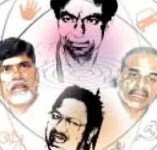Telugu channels in election mode

The general election season is upon us. The juggernaut of Indian democracy is lumbering up to roll … and its festive season for the 24/7 news channels.
In fact, what with launches of new parties, road shows, mergers and defections, Telugu channels have been put in election mode over the last several months by the political parties. The Telugu news market is getting crowded: there are five news channels in the market and four more are expected to launch soon.
Within this cacophony of daily TV news, several strategies are being adopted by channels which, as part of its election expenditure monitoring, the Election Commission needs to take account of:
· TV9 has been hosting a one-hour phone-in programme with the chief minister. This follows in the tradition of the former chief minister, who used a slot on Doordarshan for taking ‘government to the public’. Neither then, nor now, is it known whether the channels are being paid by the government for the air-time.
· One of the channels (TV5) telecasts a one-hour phone-in programme with a minor religious head with political aspirations for leadership of both his community, and the state. It is believed that the phone-in programme is being paid for by this person. It is worth considering if this is on popular demand.
· Again, TV9 telecast a similar phone-in programme with a senior politician.
In all the cases, the programmes are anchored by regular anchors who are closely identified with news and current affairs content of the channels, giving an impression that all the programmes are in the public interest.
· While the channels are within their rights to telecast such programmes, it should be mandatory for them to disclose if the programmes are sponsored/paid for by the participants,
· Also, that it is not a general programming initiative of the channel.
It is the viewer’s right to know who is underwriting the cost. In election season, the content of the programmes is likely to get increasingly partisan, and the viewer needs to be aware if such content is being paid for by the interested parties. (Fortunately, in case of five-minute-long promos of lucky gems and stones, the Telugu channels do superimpose the word ‘advertisement’ on the footage.)
Similarly, in case of paid-for programming, ‘supported by ….’ should be mandatory, and popular anchors and presenters associated with routine ‘fact’ programming of the channels, must refrain from presenting the programmes.
In case of print journalism, sponsored pages are given distinctly different fonts and layout, in addition to clearly letting the reader know that the content is paid for. Generally such content is not listed on the contents page.
Another related issue is the word ‘live’ that appears on the screens for many of the pre-recorded programmes that may include phone-ins too. These have been heavily edited and sanitised, to suit the point of view of the channels. The viewers are under the impression that a programme is ‘live’, when in fact, it has been pre-recorded and edited. The viewers’ judgement of a programme or speaker in a spontaneous and candid discussion is unlikely to be the same, if s/he is being shown a heavily edited version that masquerades as a live programme.
The more disturbing aspect of such programmes is the phone-in element. If it is pre-recorded, if the channel is putting callers through, how have these callers been lined up? Who is calling, and what are they saying?
· It should be mandatory on the channels to disclose that a programme is pre-recorded. If for some reason the channel has to use footage telecast already with ‘live’ on it, the channels must mask the word. In some instances, not masking causes confusion when the channels suddenly begin to re-play footage of terror attacks etc. with ‘live’ still on it, giving the misleading impression to viewers that this is happening at the moment.
A more old fashioned concern is that of ‘equal time’ and ‘fair play’ principles, which were very much an issue for broadcasters during election time. The news broadcast code of the government takes it seriously and tries to push it in letter, if not in spirit. But private broadcasters do not allow their style to be cramped by any such limitation.
A related issue is the problem of some political entities and their friends being able to spend heavily on media publicity, while passing it of as programming generated by the channels in the public interest. When an attempt is made to bring in voices that are contrary to what the channels wish to promote, the ‘so called live’ programmes edit out the undesirable parts, which could well be characterised as an unethical manipulation of content.
It is thus imperative that, during the process of electioneering, the Election Commission must pay attention to the uses and abuses of media by candidates, political parties and partisan lobbies, and also expose the extent of concealed expenditure.






